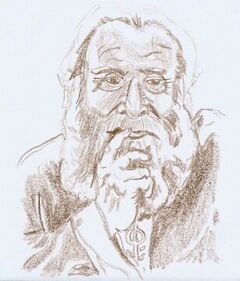Riktor
| Riktor | |
 | |
| Name | Riktor |
| Race | Human |
| Age | |
| Occupation | Wizard |
| Physical appearance | |
| Residence | Unseen University, Ankh-Morpork |
| Death | died some time ago |
| Parents | |
| Relatives | |
| Children | |
| Marital Status | |
| Appearances | |
| Books | Moving Pictures |
| Cameos | Soul Music |
Also known as "Numbers Riktor", "Riktor the Counter", and "Riktor the Tinkerer". This wizard was convinced that the universe is made out of numbers. (Oddly enough, or perhaps fittingly enough, in Equal Rites, when Simon is taken hostage by the Things in the Dungeon Dimensions, he demonstrates various models of sustainable worlds to an audience of nightmares. When you get past the weirdness of a spherical world, and the sinister nature of one encircled by a self-devouring serpent with a tree growing through its hub, this is exactly what he demonstrates all matter to be made of. Swirling, ever-changing numbers.)
Ignorant of Simon, and to prove his point, Riktor went on to invent several machines:
- The resograph (a "thingness-writer"), which measures disturbances in reality, which expels steel balls from small apertures with a 'plib' sound when reality is being disturbed. During the events of Moving Pictures these were being expelled at a rate entirely unheard of in the Disc's history.
- The Star Enumerator
- The Mouse Counter
- The Swamp Meter
- The Rev Counter for Use in Ecclesiastical Areas
It was revealed in Moving Pictures that, in his youth, Riktor scaled the Temple of Small Gods with Windle Poons and Greyhald Spold, implying that this genius was once an ordinary student wizard. Of course, this would have been a long time ago, as he was a lecturer when Ridcully was a student.
Annotation
The resograph is based on a fascinating and ancient Roundworld object: the second-century Han Dynasty seismograph. In 132 AD (!), Zhang Heng presented to the Han court what many historians consider to be his most impressive invention, the first seismometer. It was named Houfeng didong yi (候风地动仪, lit. "instrument for measuring the seasonal winds and the movements of the Earth"), and it was able to determine the exact direction (out of eight directions) of tremors and earthquakes. According to the Book of Later Han (compiled by Fan Ye in the 5th century), his bronze urn-shaped device, with a swinging pendulum inside, was able to detect the direction of an earthquake hundreds of miles/kilometers away. This was essential for the Han government in sending quick aid and relief to regions devastated by this natural disaster. The device was considered important enough to be mentioned in the "Annals" chapter of the Book of Later Han, detailing the reign of Emperor Shun.
To indicate the direction of a distant earthquake, Zhang's device dropped a bronze ball from one of eight tubed projections shaped as dragon heads; the ball fell into the mouth of a corresponding metal object shaped as a toad, each representing a direction like the points on a compass rose. His device had eight mobile arms (for all eight directions) connected with cranks having catch mechanisms at the periphery. When tripped, a crank and right angle lever would raise a dragon head and release a ball which had been supported by the lower jaw of the dragon head. His device also included a vertical pin passing through a slot in the crank, a catch device, a pivot on a projection, a sling suspending the pendulum, an attachment for the sling, and a horizontal bar supporting the pendulum.
In keeping with the seismograph and with measuring things numerically, Riktor is similar in pronunciation to Richter, of earthquake-intensity fame.